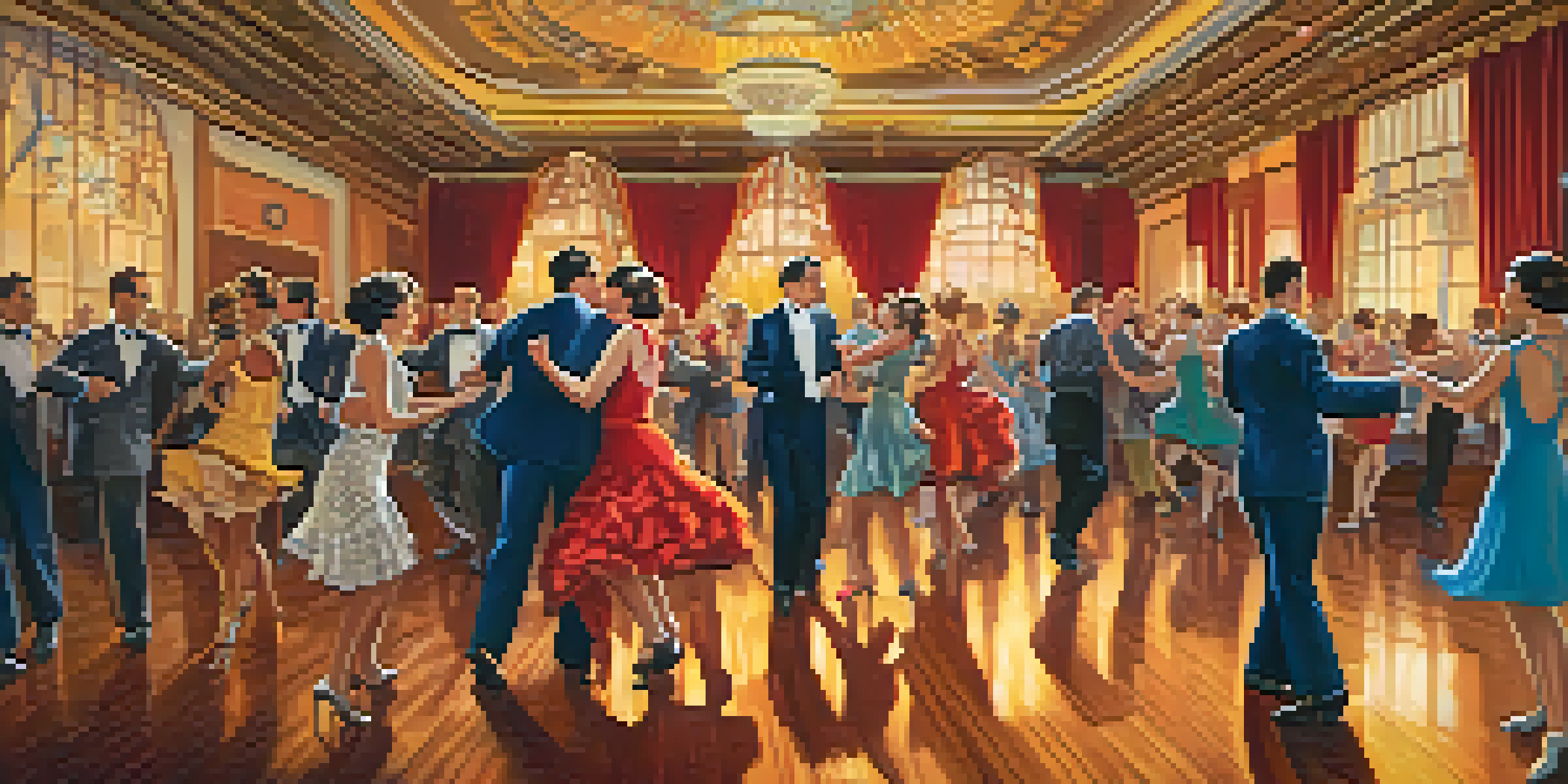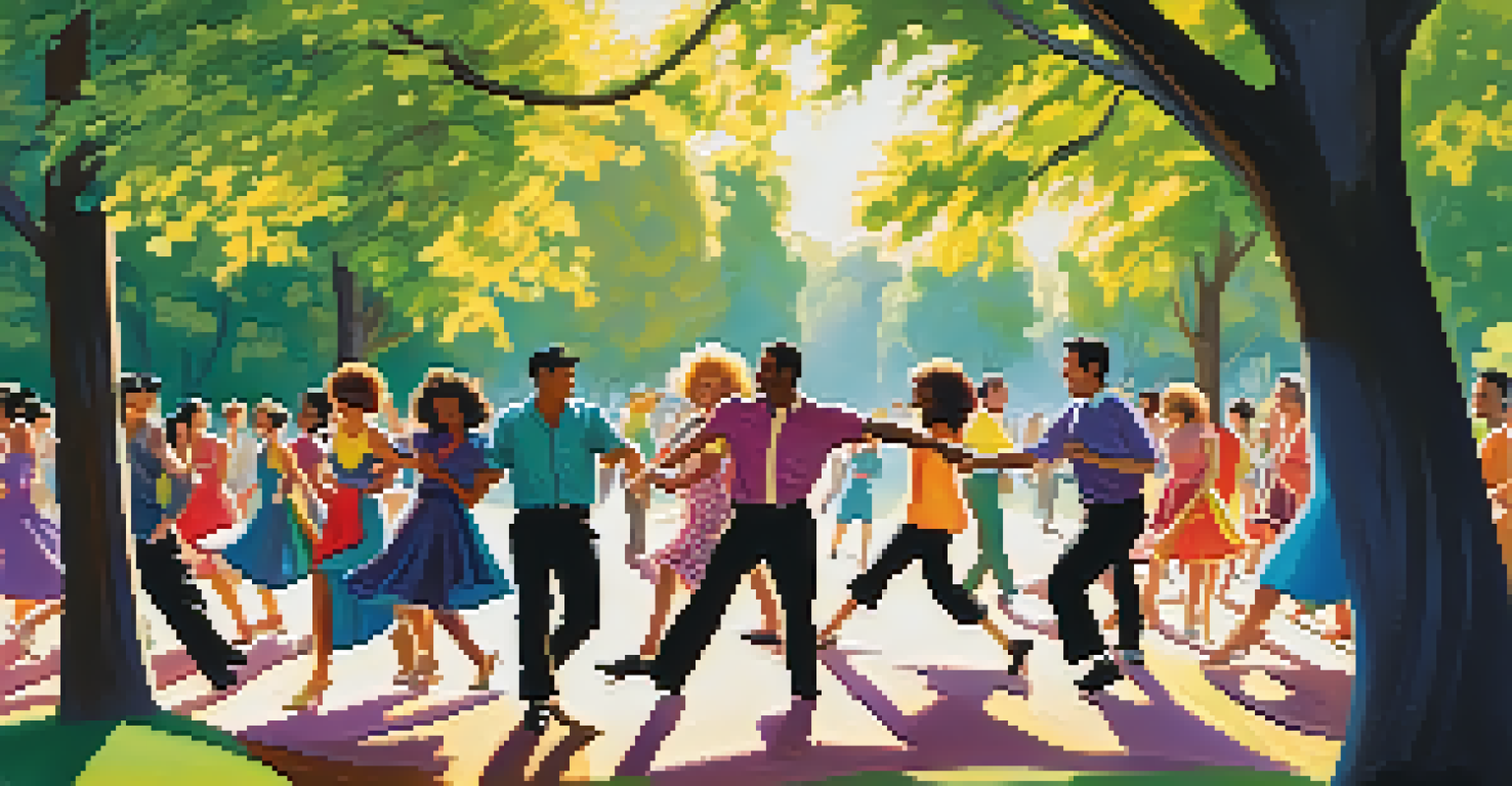The Rise of Swing Dancing: History, Styles, and Community

The Origins of Swing Dancing: A Historical Overview
Swing dancing has its roots in the early 20th century, emerging from African American communities in Harlem. It developed alongside jazz music, becoming a vibrant expression of cultural identity. The dance style gained popularity in the 1920s and 30s, with iconic venues like the Savoy Ballroom hosting legendary dancers and musicians.
Dancing is like dreaming with your feet.
As swing music evolved, so did the dance styles associated with it, notably the Lindy Hop and Charleston. These dances were characterized by energetic movements and improvisation, reflecting the upbeat rhythms of jazz. The combination of music and dance created a lively atmosphere that encouraged social interaction and creativity.
The rise of swing dancing was fueled further by the Great Depression, offering an affordable form of entertainment. People flocked to dance halls to escape the hardships of everyday life, fostering a sense of community. This period laid the groundwork for swing dancing to flourish and evolve over the decades.
The Swing Dance Styles: A Closer Look
Swing dancing encompasses several styles, each with its unique flair and history. The most popular styles include the Lindy Hop, East Coast Swing, and West Coast Swing. Each style has its own distinctive movements and rhythms, making swing dancing a versatile and exciting form of expression.

The Lindy Hop, often considered the original swing dance, features a mix of six and eight-count patterns, allowing for intricate footwork and aerial moves. In contrast, East Coast Swing is a simpler variation that is easier for beginners to learn, focusing on a fun, bouncy feel. West Coast Swing, on the other hand, is characterized by its smooth, slotted style, making it adaptable to a variety of music genres.
Swing Dancing's Rich History
Emerging from Harlem's African American communities, swing dancing evolved alongside jazz music, becoming a vibrant cultural expression.
These styles not only highlight the creativity of dancers but also reflect the cultural shifts throughout history. As swing dancing spread globally, new interpretations and blends emerged, enriching the dance landscape. This evolution showcases the adaptability and enduring appeal of swing dancing across generations.
The Influence of Swing Music on Dance Styles
Swing music plays a crucial role in shaping the various styles of swing dancing, as the rhythm and tempo directly influence the dancers' movements. Jazz bands, with their improvisational flair, provided the perfect backdrop for dancers to showcase their skills. The infectious energy of swing music invites performers to express themselves through spontaneous, playful movements.
The only dancer you should compare yourself to is the one you used to be.
As swing music evolved, so did the dance styles associated with it. The transition from big band sounds to smaller jazz ensembles allowed for more intimate dance settings. This shift encouraged dancers to explore new rhythms and styles, fostering creativity and innovation within the community.
Moreover, the revival of swing music in the late 20th century sparked a renewed interest in swing dancing. Modern bands began to incorporate swing elements into their music, prompting a resurgence in dance classes and events. This revival not only connected new dancers with the rich history of swing but also reinforced the bond between music and movement.
The Role of Community in Swing Dancing
Community is at the heart of swing dancing, bringing people together to share a passion for music and movement. Dance studios, local clubs, and events create a welcoming environment for dancers of all skill levels. This sense of belonging fosters friendships and connections, making swing dancing not just a hobby, but a lifestyle for many.
Events like dance exchanges and competitions further strengthen the community, allowing dancers to meet and learn from one another. These gatherings celebrate diversity and inclusion, encouraging participants to embrace their individuality while connecting through a shared love of dance. The supportive atmosphere helps newcomers feel comfortable, promoting growth and confidence.
Diverse Swing Dance Styles
Swing dancing includes various styles like Lindy Hop and West Coast Swing, each offering unique movements that showcase the dance's versatility.
Additionally, social media has played a significant role in building the swing dancing community. Online platforms allow dancers to share experiences, learn from tutorials, and stay updated on events. This virtual connection complements in-person gatherings, expanding the reach of swing dancing and inspiring new enthusiasts.
The Resurgence of Swing Dancing in Popular Culture
In recent years, swing dancing has experienced a remarkable resurgence in popular culture, thanks in part to movies and television shows that celebrate the dance. Films like 'Swing Kids' and 'The Aviator' highlighted the vibrant world of swing, introducing new audiences to its infectious energy. This renewed interest has breathed new life into dance studios and clubs worldwide.
Television shows featuring swing dance competitions have also contributed to its popularity. Programs like 'So You Think You Can Dance' showcase talented dancers performing impressive swing routines, captivating viewers and inspiring them to take lessons. This exposure has helped demystify swing dancing, making it more accessible to a broader audience.
Moreover, the rise of social media has allowed swing dancers to showcase their talent and creativity, drawing in new enthusiasts. Platforms like Instagram and TikTok have become hotspots for swing dance content, encouraging the sharing of tutorials, performances, and community events. This online presence has solidified swing dancing as a contemporary and relevant art form.
Learning Swing Dancing: Resources and Tips
For those interested in diving into the world of swing dancing, numerous resources are available to help you get started. Local dance studios often offer beginner classes, where you can learn the basics in a supportive environment. Additionally, many online platforms provide instructional videos, making it easy to practice at home.
Joining a local dance community or attending social dance events is a fantastic way to meet fellow dancers and gain confidence. These gatherings often feature live music, allowing you to experience the joy of dancing with others. Don't be afraid to ask questions and seek advice from more experienced dancers—they're usually more than happy to help!
Community Drives Swing Dancing
The sense of belonging within the swing dancing community fosters friendships and promotes growth, making it a lifestyle for many enthusiasts.
Lastly, remember that swing dancing is all about having fun and expressing yourself. Embrace the learning process, and don't be discouraged by mistakes. As you practice and grow, you'll discover your unique style and develop lasting friendships within the vibrant swing dance community.
The Future of Swing Dancing: Trends and Innovations
As swing dancing continues to evolve, new trends and innovations are emerging, shaping its future. The integration of various dance styles, such as hip-hop and contemporary, is creating fresh interpretations of swing. This blending of genres allows dancers to explore new movements and expressions, keeping the art form dynamic and relevant.
Technological advancements are also influencing the world of swing dancing. Virtual classes and workshops have become increasingly popular, enabling dancers to connect with instructors and peers worldwide. This accessibility opens doors for individuals who may not have local swing dancing opportunities, expanding the community and fostering global connections.

Moreover, the growing emphasis on inclusivity and diversity within the swing dance community is paving the way for a brighter future. Dancers from various backgrounds are being celebrated, bringing unique perspectives and styles to the dance floor. This focus on inclusivity not only enriches the community but also ensures that swing dancing remains a welcoming space for everyone.